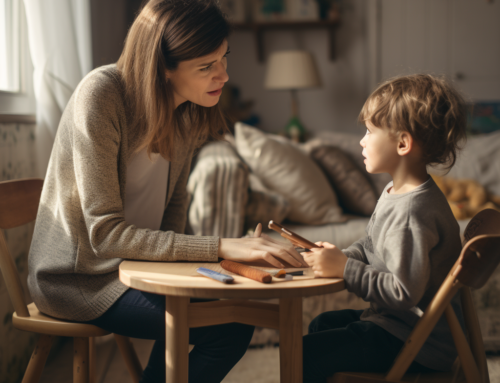As a parent, you know the magic of toys. They spark imagination, fuel laughter, and provide endless hours of entertainment.
But did you know that the right toys can also play a crucial role in your child’s early speech and language development?
Speech therapy, especially in the early years, is an incredible journey of growth and discovery. While therapy sessions themselves are packed with valuable exercises and activities, incorporating the right toys at home can significantly boost progress and make learning fun.
But with countless options available, choosing the “best” toys can feel overwhelming.
Worry not, fellow parents and caregivers!
This guide will equip you with the knowledge and inspiration to navigate the wonderful world of speech therapy toys.
Remember, the best toy isn’t always the one with the most bells and whistles, but the one that sparks your child’s interest, encourages interaction, and aligns with their specific speech and language goals.
Tailoring the Playroom to Speech Goals:
Before diving into the toy chest, let’s take a moment to understand the different areas speech therapy addresses. This will help you select toys that target your child’s specific needs:
- Articulation: This focuses on producing individual sounds correctly. Think tongue twisters, mirrors for visualizing placement, and fun blowing toys to strengthen oral muscles.
- Language Skills: This encompasses vocabulary, grammar, and sentence structure. Picture books, storytelling puppets, and matching games can work wonders here.
- Social Skills: Turn-taking, collaboration, and expressing emotions are key. Board games, dramatic play sets, and even dolls and stuffed animals can foster these skills.
Toys for Articulation
Let’s get those little mouths moving and mastering those tricky sounds! Here are some toy ideas:
- Articulation mirrors: These handy tools help children see their tongue placement in action, making sound production more concrete. Imagine the giggles as they practice their “puh” sounds with a big smile in the mirror!
- Blowing toys: From classic pinwheels to harmonicas and whistles, blowing toys strengthen the oral muscles crucial for clear speech. Plus, the fun factor is undeniable!
- Sensory chew toys: These textured wonders provide oral stimulation and can help regulate sensory needs, making practicing sounds more comfortable and engaging.
- Musical instruments: From drums to xylophones, musical instruments encourage sound exploration and imitation, making learning fun and melodic.
Toys for Building Language Skills
Ready to embark on a language-learning expedition? Pack your imagination and these toys:
- Picture books: The vibrant world of picture books introduces new vocabulary, ignites curiosity, and sparks conversations. Reading together is a bonding experience that nurtures language development naturally.
- Storytelling puppets: Shy little voices blossom with the help of furry or felt friends. Puppets encourage creative expression, narrative skills, and turn-taking, making language learning interactive and enjoyable.
- Matching games: Memory games and picture-matching activities not only develop cognitive skills but also introduce new vocabulary and concepts in a playful way.
- Sorting toys: From colorful blocks to shape sorters, sorting toys lay the foundation for language skills by introducing basic concepts like colors, shapes, and sizes, all while encouraging descriptive language.
Toys for Social Skills
Let’s help your child blossom into a confident communicator and social butterfly! Here are some toy ideas:
- Dolls and stuffed animals: These cuddly companions are more than just bedtime buddies. They provide a safe space for practicing social interactions, expressing emotions, and taking turns during pretend play.
- Board games: From classics like Candy Land to cooperative games, board games teach turn-taking, patience, and communication in a fun and engaging way.
- Cooperative toys: Building a marble run together or working as a team to complete a puzzle fosters collaboration, problem-solving, and communication skills in a positive and supportive environment.
- Dramatic play sets: Doctor kits, kitchens, and construction sets provide endless opportunities for imaginative play, allowing children to experiment with different roles, express themselves, and interact with others.
Toys for Versatility
Sometimes, the simplest toys spark the most creativity and language development. Here are some versatile options:
- Blocks: From classic wooden blocks to magnetic tiles, blocks encourage open-ended play, problem-solving, and storytelling. They also provide opportunities for introducing new vocabulary related to size, shape, and spatial concepts.
- Play dough: Squishing, molding, and sculpting play dough is not just sensory fun; it strengthens fine motor skills and encourages storytelling and creative expression. Imagine the language-rich narratives that unfold as your child builds a play dough castle!
- Sensory bins: Filled with rice, beans, or even water beads, sensory bins are a treasure trove of tactile exploration and language development. Hiding objects and describing them as you dig them out, or creating miniature worlds with the materials, fosters vocabulary growth and imaginative storytelling.
- Art supplies: Crayons, paints, and markers aren’t just for creating masterpieces; they’re tools for self-expression and communication. Encourage your child to draw or paint about their experiences, stories, or emotions, and watch their language skills flourish.
The Best Toy is the One You Play With
While this guide provides a starting point, remember that the most powerful tool in your child’s speech therapy journey is you!
Here are some additional tips to make playtime a language-rich experience:
- Get down to their level: Literally! Kneel or sit on the floor to make eye contact and create a sense of connection.
- Follow their lead: Let your child’s interests guide playtime. This keeps them engaged and creates opportunities to introduce new vocabulary and concepts related to their favorite things.
- Narrate your actions: Describe what you’re doing as you play, whether it’s building a block tower or sorting shapes. This exposes your child to new words and sentence structures in a natural context.
- Ask open-ended questions: Instead of yes/no questions, ask questions that encourage your child to elaborate and use more descriptive language. For example, instead of “Do you like this toy?”, ask “What do you like to do with this toy?”
- Make it fun and silly: Laughter is the best medicine, and it’s also a powerful tool for learning. Don’t be afraid to get silly, sing songs, and make playtime an enjoyable experience.
Remember, consistency is key. By incorporating these tips and choosing toys that align with your child’s speech goals, you can turn playtime into a springboard for language development and create lasting memories along the way.




